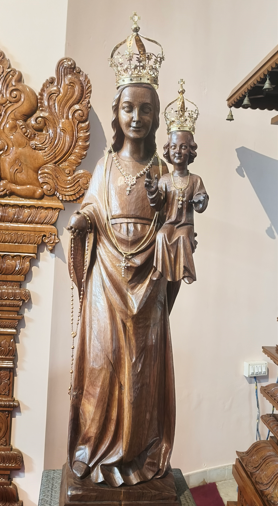Shining with Mary: Wolff’s Meditation on Her Crown
09 Sep 2025 - 30 Sep 2025
In September, the Church honors three Marian feasts: the Nativity of Mary on the 8th, the Holy Name of Mary on the 12th, and Our Lady of Sorrows on the 15th. As Mother Mary is one of the patrons of our congregation, our founder, Fr. Wolff, reminds us that true religious life can only be lived by following her simplicity and striving for her perfection.
Earlier this year, we reflected on Mary as Mother of God, Queen of Peace, and on embracing the way of humility through Mary, and last month on Mary as Mother of God and Mother of the Church. This month, as we celebrate the trio of Marian feasts, we turn to Fr. Wolff’s reflection on the twelve stars of Mary’s crown.
The crown of twelve stars comes from the Book of Revelation (12:1), where St. John describes a ‘woman clothed with the sun’ crowned with twelve stars. These stars symbolize the fullness of God’s people, that is the twelve tribes of Israel and the twelve apostles, embracing both the Old and New Testament and representing the whole Church.
Fr. Wolff interprets this image in a striking way
“The Blessed Virgin Mary is that blessed woman of whom St. John says that he saw her crowned with twelve stars. And indeed, is not such a holy head worthy to be thus crowned? Or should one not rather say that her excellent head crowns the stars rather than is crowned by them?
But what are these twelve stars other than twelve privileges of Mary?

Wooden Statue of Mother Mary at JMJ Provincialate, Mangalagiri.
1° She is without original sin.
2° From the beginning of the world she was prefigured by all kinds of figures and prophecies.
3° She was the first of all to consecrate her virginity to God.
4° She was greeted by an Angel.
5° In a wondrous manner, without pain, she became the Mother of Jesus.
6° She remained always a virgin.
7° She is the Mother of God, since her Son is God.
8° She never stained her soul with a sin.
9° After her death she was not subjected to corruption.
10° She was assumed into heaven with body and soul.
11° She is exalted above all other Saints.
12° Therefore she can also obtain more for us than all the other Saints.
O what outstanding exaltation! I stand amazed at the goodness of God, who has granted so many privileges to a creature, and I see from this how much I can obtain for myself and also for others, if I cooperate with God’s grace. Therefore I will do my best to live and to die after the example of Mary, my dear Mother”. (Wolff, Grondregels, 385)
For us as sisters, Wolff’s meditation on Mary’s crown is a gentle reminder that holiness is not an unreachable ideal but a path we are called to walk daily. Each “star” in Mary’s crown speaks to us of a virtue or grace that can also take root in our own lives if we remain open to God. In community life, we recognize “stars” that guide our common journey: patience in misunderstandings, kindness in our speech, openness in communication, forgiveness when hurts arise, generosity in service, respect for one another’s differences, a spirit of gratitude for daily blessings, humility in accepting correction, simplicity in our way of living, fidelity to our vows and commitments, encouragement in times of struggle, and prayerfulness that keeps God at the center of all we do. These small but steady lights shape our ordinary days and, when lived with love, they crown our community life with peace and joy. Mary lived them first, and now she lights the way for us. When we struggle with weakness or discouragement, her crown reassures us that God’s grace is stronger than our limits.
Wolff’s amazement at Mary’s privileges should become our own amazement at God’s goodness to us. If we truly believe, like him, that Mary’s crown is also a promise of what grace can do in us, then our vocation becomes not a burden but a joyful path where we, too, can reflect God’s light for the people we serve.

